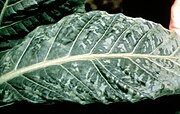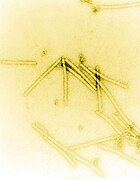Portal:Viruses
The Viruses Portal
Welcome!

Viruses are small infectious agents that can replicate only inside the living cells of an organism. Viruses infect all forms of life, including animals, plants, fungi, bacteria and archaea. They are found in almost every ecosystem on Earth and are the most abundant type of biological entity, with millions of different types, although only about 6,000 viruses have been described in detail. Some viruses cause disease in humans, and others are responsible for economically important diseases of livestock and crops.
Virus particles (known as virions) consist of genetic material, which can be either DNA or RNA, wrapped in a protein coat called the capsid; some viruses also have an outer lipid envelope. The capsid can take simple helical or icosahedral forms, or more complex structures. The average virus is about 1/100 the size of the average bacterium, and most are too small to be seen directly with an optical microscope.
The origins of viruses are unclear: some may have evolved from plasmids, others from bacteria. Viruses are sometimes considered to be a life form, because they carry genetic material, reproduce and evolve through natural selection. However they lack key characteristics (such as cell structure) that are generally considered necessary to count as life. Because they possess some but not all such qualities, viruses have been described as "organisms at the edge of life".
Selected disease
Chickenpox is caused by initial infection with varicella zoster virus, a DNA virus of the Alphaherpesvirinae subfamily. The virus naturally infects only humans, but some other primates have been infected artificially. Symptoms appear 10–21 days after exposure: an itchy vesicular skin rash, and small ulcers in the oral cavity and tonsil areas. The rash usually resolves by 7 days, but the virus remains latent in nerve cell bodies, and can emerge years or decades later to cause shingles. Chickenpox is transmitted by the respiratory route, as well as direct contact with lesions.
A classic disease of childhood, the highest prevalence occurs at 4–10 years. Chickenpox is rarely fatal in people with a normal immune system, with around 6,400 deaths worldwide in 2015, about 1 in 60,000 infections. Adults often have more severe symptoms than children, and are at higher risk of complications such as pneumonia, bronchitis, hepatitis and encephalitis. Pregnant women and people with a suppressed immune system have the highest complication risk. Chickenpox during the first 28 weeks of gestation can lead to foetal malformations. Infection in adults is usually treated with antiviral drugs, such as aciclovir or valaciclovir, which reduces symptom severity and the risk of complications. A vaccine is available.
Selected image
Muhammad ibn Zakariya al-Razi was a Persian physician and chemist who, in the 9th century, was the first to document the distinction between the diseases of measles and smallpox.
Credit: Gerard of Cremona (c. 1250–60)
In the news
26 February: In the ongoing pandemic of severe acute respiratory syndrome coronavirus 2 (SARS-CoV-2), more than 110 million confirmed cases, including 2.5 million deaths, have been documented globally since the outbreak began in December 2019. WHO
18 February: Seven asymptomatic cases of avian influenza A subtype H5N8, the first documented H5N8 cases in humans, are reported in Astrakhan Oblast, Russia, after more than 100,0000 hens died on a poultry farm in December. WHO
14 February: Seven cases of Ebola virus disease are reported in Gouécké, south-east Guinea. WHO
7 February: A case of Ebola virus disease is detected in North Kivu Province of the Democratic Republic of the Congo. WHO
4 February: An outbreak of Rift Valley fever is ongoing in Kenya, with 32 human cases, including 11 deaths, since the outbreak started in November. WHO
21 November: The US Food and Drug Administration (FDA) gives emergency-use authorisation to casirivimab/imdevimab, a combination monoclonal antibody (mAb) therapy for non-hospitalised people twelve years and over with mild-to-moderate COVID-19, after granting emergency-use authorisation to the single mAb bamlanivimab earlier in the month. FDA 1, 2
18 November: The outbreak of Ebola virus disease in Équateur Province, Democratic Republic of the Congo, which started in June, has been declared over; a total of 130 cases were recorded, with 55 deaths. UN
Selected article
Plant viruses face different challenges from animal viruses. As plants do not move, transmission between hosts often involves vectors, most commonly insects, but also nematodes and protozoa. Plant viruses can also spread via seeds, and by direct transfer of sap. Plant cells are surrounded by cell walls which are difficult to penetrate. Movement between cells occurs mainly by transport through plasmodesmata, and most plant viruses encode movement proteins to make this possible. Although plants lack an adaptive immune system, they have complex defences against viral infection. Viruses of cultivated plants often cause disease, and are thought to cause up to US$60 billion losses to global crop yields each year; infections of wild plants are often asymptomatic.
Most plant viruses are rod-shaped, with protein discs forming a tube surrounding the viral genome; isometric particles are another common structure. They rarely have an envelope. The great majority have an RNA genome, which is usually small and single stranded. Plant viruses are grouped into 73 genera and 49 families. Tobacco mosaic virus (pictured) is among the best characterised of the 977 species officially recognised in 1999.
Selected outbreak
The 2009 flu pandemic was an influenza pandemic first recognised in Mexico City in March 2009 and declared over in August 2010. It involved a novel strain of H1N1 influenza virus with genes from five different viruses, which resulted when a previous triple reassortment of avian, swine and human influenza viruses further combined with a Eurasian swine influenza virus, leading to the term "swine flu" being used for the pandemic. It was the second pandemic to involve an H1N1 strain, the first being the 1918 "Spanish flu" pandemic.
The global infection rate was estimated as 11–21%. This pandemic strain was less lethal than previous ones, killing about 0.01–0.03% of those infected, compared with 2–3% for Spanish flu. Most experts agree that at least 284,500 people died, mainly in Africa and Southeast Asia – comparable with the normal seasonal influenza fatalities of 290,000–650,000 – leading to claims that the World Health Organization had exaggerated the danger.
Selected quotation
| “ | Some scientists visualize the virus as an ill-defined shape emerging bashfully out of a dense and golden cloud. This is a beautiful and romantic vision. Virology should, however, not be too Turnerian. Nor should it be an abstract art. The portrait of a virus should not produce an aesthetic emotion by means of an organic disturbance. | ” |
Recommended articles
Viruses & Subviral agents: bat virome • elephant endotheliotropic herpesvirus • HIV • introduction to viruses![]() • Playa de Oro virus • poliovirus • prion • rotavirus
• Playa de Oro virus • poliovirus • prion • rotavirus![]() • virus
• virus![]()
Diseases: colony collapse disorder • common cold • croup • dengue fever![]() • gastroenteritis • Guillain–Barré syndrome • hepatitis B • hepatitis C • hepatitis E • herpes simplex • HIV/AIDS • influenza
• gastroenteritis • Guillain–Barré syndrome • hepatitis B • hepatitis C • hepatitis E • herpes simplex • HIV/AIDS • influenza![]() • meningitis
• meningitis![]() • myxomatosis • polio
• myxomatosis • polio![]() • pneumonia • shingles • smallpox
• pneumonia • shingles • smallpox
Epidemiology & Interventions: 2007 Bernard Matthews H5N1 outbreak • Coalition for Epidemic Preparedness Innovations • Disease X • 2009 flu pandemic • HIV/AIDS in Malawi • polio vaccine • Spanish flu • West African Ebola virus epidemic
Virus–Host interactions: antibody • host • immune system![]() • parasitism • RNA interference
• parasitism • RNA interference![]()
Methodology: metagenomics
Social & Media: And the Band Played On • Contagion • "Flu Season" • Frank's Cock![]() • Race Against Time: Searching for Hope in AIDS-Ravaged Africa
• Race Against Time: Searching for Hope in AIDS-Ravaged Africa![]() • social history of viruses
• social history of viruses![]() • "Steve Burdick" • "The Time Is Now" • "What Lies Below"
• "Steve Burdick" • "The Time Is Now" • "What Lies Below"
People: Brownie Mary • Macfarlane Burnet![]() • Bobbi Campbell • Aniru Conteh • people with hepatitis C
• Bobbi Campbell • Aniru Conteh • people with hepatitis C![]() • HIV-positive people
• HIV-positive people![]() • Bette Korber • Henrietta Lacks • Linda Laubenstein • Barbara McClintock
• Bette Korber • Henrietta Lacks • Linda Laubenstein • Barbara McClintock![]() • poliomyelitis survivors
• poliomyelitis survivors![]() • Joseph Sonnabend • Eli Todd • Ryan White
• Joseph Sonnabend • Eli Todd • Ryan White![]()
Selected virus
Tobacco mosaic virus (TMV) is an RNA virus in the Virgaviridae family that infects a wide range of plants, including tobacco, tomato, pepper, other members of the Solanaceae family, and cucumber. The rod-shaped virus particle is around 300 nm long and 18 nm in diameter, and consists of a helical capsid made from 2130 copies of a single coat protein, which is wrapped around a positive-sense single-stranded RNA genome of around 6400 bases. The coat protein and RNA can self-assemble to produce infectious virus.
Infection often causes characteristic patterns, such as "mosaic"-like mottling and discoloration on the leaves, but is almost symptomless in some host species. TMV causes an economically important disease in tobacco plants. Transmission is frequently by human handling, and prevention of infection involves destroying infected plants, hand washing and crop rotation to avoid contaminated soil. TMV is one of the most stable viruses known. The fact that it does not infect animals and can readily be produced in gramme amounts has led to its use in numerous pioneering studies in virology and structural biology. TMV was the first virus to be discovered and the first to be crystallised.
Did you know?
- ...that virologist Harald zur Hausen received both the Gairdner Foundation International Award and the Nobel Prize in Physiology or Medicine in 2008?
- ...that in 2007, the first Australian outbreak of equine influenza caused a nationwide ban on horse racing?
- ...that Michael S. Gottlieb was instrumental in identifying AIDS in 1981 and thereafter treated actor Rock Hudson for the disease?
- ...that the tick Ornithodoros erraticus spreads the African swine fever virus in the Iberian Peninsula (Spain and Portugal)?
- ...that the CEO of CEPI, a key organisation in the race to develop a vaccine for COVID-19, has called the disease "the most frightening" that he has ever encountered in his career?
Selected biography
George Keble Hirst (2 March 1909 – 22 January 1994) was an American virologist who was among the first to study the molecular biology and genetics of animal viruses.
Hirst started to work on influenza virus in 1940, only a few years after it had been isolated. He soon discovered that the virus caused red blood cells to clump together. This phenomenon could be used to diagnose influenza, which had previously required growing the virus in ferrets. He invented the haemagglutination assay, a simple method for quantifying viruses, and later the haemagglutination inhibition assay, which measures virus-specific antibodies in serum. In 1942, he discovered the neuraminadase enzyme, showing for the first time that viruses could contain enzymes. Neuraminidase is the target of the neuraminidase inhibitor class of antiviral drugs, including oseltamivir and zanamivir. In 1962, he was also the first to propose the then-revolutionary idea that virus genomes can consist of discontinuous segments.
He co-founded Virology in 1955, the first English-language journal to focus on viruses, and directed the Public Health Research Institute in New York City for nearly 25 years (1956–81).
In this month
5 June 1981: First report of HIV/AIDS (symbol pictured) appeared in medical literature
6 June 1997: Gene silencing in plants shown to be a viral defence mechanism
7–13 June 1962: Donald Caspar and Aaron Klug proposed the quasi-equivalence principle of virus structure
7–13 June 1962: André Lwoff proposed a viral classification scheme based on nature of genome, type of symmetry and presence of envelope
7–13 June 1962: George Hirst proposed that the influenza virus genome is segmented
9 June 1981: The American Society for Virology was founded
13 June 2012: First case of Middle East respiratory syndrome coronavirus (MERS-CoV) occurred in Saudi Arabia
18 June 1981: A vaccine against foot-and-mouth disease was the first genetically engineered vaccine
21 June 1996: Nevirapine approved, first NNRTI for HIV/AIDS
26 June 1993: Clinical trial of hepatitis B virus drug fialuridine terminated; the drug caused several fatalities due to lactic acidosis
28 June 2011: FAO declared rinderpest eradicated
30 June 1985: Ryan White was denied re-admittance to his school after an AIDS diagnosis, in a case that changed public perceptions of the disease
Selected intervention
Two polio vaccines are used against the paralytic disease polio. The first, developed by Jonas Salk, consists of inactivated poliovirus. Based on three wild virulent strains, inactivated using formalin, it is administered by injection and is very safe. It confers IgG-mediated immunity, which prevents poliovirus from entering the bloodstream and protects the motor neurons, eliminating the risk of bulbar polio and post-polio syndrome. The second, developed by Albert Sabin, originally consisted of three live virus strains, attenuated by growth in cell culture. Since 2016, only two strains have generally been included. They contain multiple mutations, preventing them from replicating in the nervous system. The Sabin vaccine stimulates both antibodies and cell-mediated immunity, providing longer-lasting immunity than the Salk vaccine. It can be administered orally, making it more suitable for mass vaccination campaigns. In around three cases per million doses, the live vaccine reverts to a virulent form and causes paralysis. Vaccination has reduced the number of wild-type polio cases from around 350,000 in 1988 to just 33 in 2018, and eradicated the disease from most countries.
Subcategories
Subcategories of virology:
Topics
Things to do
- Comment on what you like and dislike about this portal
- Join the Viruses WikiProject
- Tag articles on viruses and virology with the project banner by adding {{WikiProject Viruses}} to the talk page
- Assess unassessed articles against the project standards
- Create requested pages: red-linked viruses | red-linked virus genera
- Expand a virus stub into a full article, adding images, citations, references and taxoboxes, following the project guidelines
- Create a new article (or expand an old one 5-fold) and nominate it for the main page Did You Know? section
- Improve a B-class article and nominate it for Good Article
 or Featured Article
or Featured Article status
status - Suggest articles, pictures, interesting facts, events and news to be featured here on the portal
WikiProjects & Portals
 WikiProject Viruses
Related WikiProjects
WikiProject Viruses
Related WikiProjects
Medicine • Microbiology • Molecular & Cellular Biology • Veterinary Medicine
Related PortalsAssociated Wikimedia
The following Wikimedia Foundation sister projects provide more on this subject:
-
Commons
Free media repository -
Wikibooks
Free textbooks and manuals -
Wikidata
Free knowledge base -
Wikinews
Free-content news -
Wikiquote
Collection of quotations -
Wikisource
Free-content library -
Wikispecies
Directory of species -
Wikiversity
Free learning tools -
Wiktionary
Dictionary and thesaurus

















